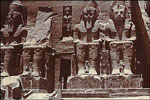|

Photography was further revolutionized by the introduction of
more accessible and more portable materials. Dry gelatin-coated
glass plates entered the market after 1880, eliminating the need
for a photographic wagon trade. At the turn of the century, roll
film and hand-held cameras made every traveler his (or her) own
photographer, at which point touristic and scientific photography
took their separate ways.
Photographers of the nineteenth century were not bound to document monuments
in a systematic fashion, but instead were making records of their
voyages and experimenting with the infant camera. At times, however,
a monument may still be available only through the work of early
photographers. In order to get what information exists on the
birth house of Cleopatra VII at Armant, one must consult the albums
of Frith, for the small temple was torn down to build a sugar
factory shortly after his visit. In 1859 Frith became the first
photographer in Nubia. There he took views of the temple of Amenhotep
III at Soleb, a monument that remains virtually unpublished. For
Armant and Soleb, Frith's pioneering documentation is ineffably
precious.
«
previous
2 of 4
next
»
|
 |

|
 |


Figure
1, Vol. II: Temple of Abu Simbel. »
| E
X P L O R E |
| The
Further Exploration page has many links to great
sites about Ancient
Egypt. |
|
|
|